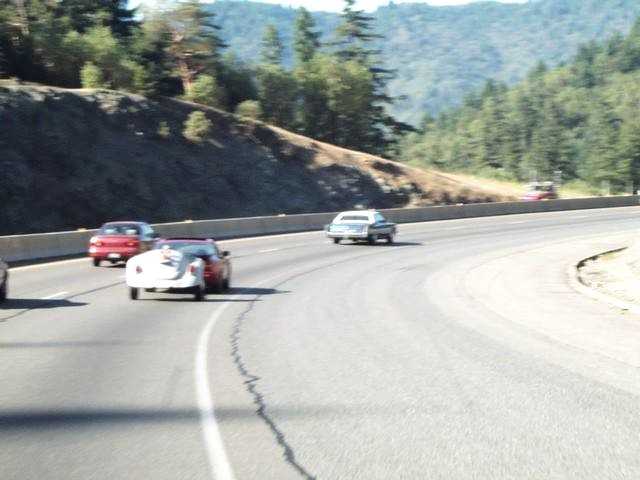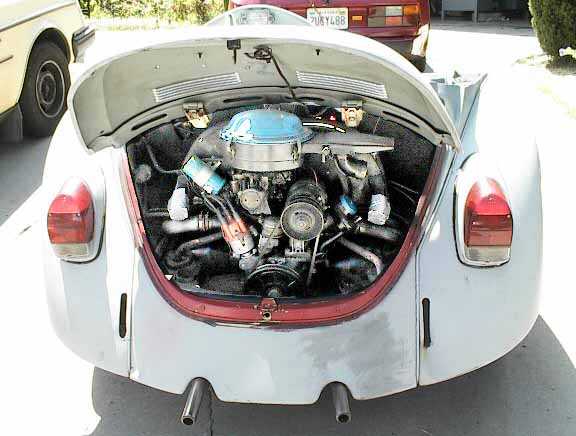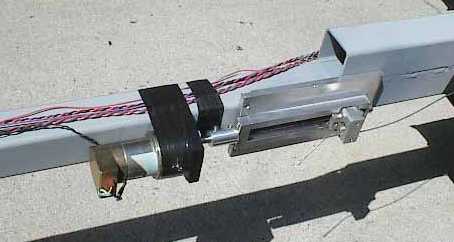
EV
Pusher Trailer
(version 1)

Recent Trips:
Palo Alto,
CA to Woodburn, OR and back (1250 mi in two days)
Top Speed: ~70 mph (flat ground, 4th gear, no electric
assist)
Top Speed: 90 mph with electric assist. (limited by IC
engine rpm)
Cruise Speed: 50-65 mph (depending on ambient
temperature...IC is air cooled)
Displacement: 1600 cc Volkswagen Bug stock engine (1971)
Transmission: '71 bug stock manual 4 speed
Efficiency: 25 mpg (EV with trailer net at 55+ mph)
Range: 300 miles (12 gallon capacity)
On the road in Oregon (400 miles from home in the same morning)

On the road in Oregon (400 miles from home in the same morning)
Why?
As anyone involved with EV's knows range is
the one central problem (combined with slow
re-charge times.) EV's will have ranges between
25-110 miles (home-built to optimized
production.) Recharge times can be as low as 1-3
hours with high capacity chargers. These
range/charge times still do not allow
long-distance freeway travel on the occasions
when it is needed.
The idea of the pusher trailer, and generator
trailer, is to give the normal EV long-range
capability with fast fuel stops without
permanently installing an IC hybrid system in
the vehicle. This saves the weight, and mess, of
having the IC engine with you (in the EV) for
the %80+ of driving that is done within the EV's
normal range. For long-range operation, the IC
engine will take over all of the load and
battery drain will cease or slowly reverse.
Generator vs. Pusher (Series vs. Parallel hybrid)
The "normal" approach to hybrid
trailers is to have an IC engine driving
a generator that sends electricity
forward to the EV to supply the energy
needed for highway cruising.
Generator benefits:
* Energy can be stored in the batteries
when IC output is more than needed.
* The IC load is very level as the
generator output can be nearly constant.
* No transmission is needed
* Standard trailer dynamics apply
However, this approach suffers from the
inherent problem that the energy is
transformed from mechanical (at the IC
shaft) into electrical, and then back to
mechanical (at the EV motor.) The energy
will in the best case go through the
generator, EV motor controller, and EV
motor. In the worst case it will also
cycle in and out of the batteries. All
of these conversions deal a serious blow
to the best efficiency possible. For a
typical EV system you will need between
1/2 and 2/3 of the IC horsepower to
simply push the car as you will to
generate enough electricity to drive it.
Pusher Benefits:
* Fewer energy conversions
Chemical--->Thermal--->Mechanical
* Less IC horsepower needed
* Potentially lighter than a gen trailer
(no generator, less fuel, less hp)
* EV system does not need to be sized
for continuous use
* Cheaper (no generator, more standard
system)
But, the pusher trailer is not at all
suited for city use. It ONLY makes sense
for long distance freeway travel. Since
the IC output can't be used unless the
car is being pushed, efficiency will
fall at slower speeds. However, the
whole premise behind the hybrid trailer
is that it is only needed for long-range
trips (where most of the time is spent
on the freeway!)
More Pictures

(image taken by brucedp at JB's home)

(image
taken by
brucedp at
JB's home)

Crowds
at Woodburn,
(world's
quickest
electric
dragster
background
above the
hood)
Control: One difficult
problem with the pusher trailer is
how to control the throttle and
transmission remotely. I have chosen
to keep all control electrical so
that there is only a simple
electrical connector to the EV. This
prototype does not yet have any
transmission control. The lights are
linked to the EV's (brake, running,
turn.) The throttle is controlled by
a small DC motor that drives a lead
screw to pull it in or let it out.
There is also a switch in series
with the IC ignition system inside
the EV.

Operation: The current
version of this trailer is fairly
difficult to use. Since there is no
transmission control, you need to
stop and get out to change gears.
Luckily, this doesn't happen to
often. For all flat freeway travel
(with small hills) 4th gear is fine.
So, just before getting on the
highway you pull over, put it in 4th
and then accelerate. As the EV
accelerates it is cranking the IC
engine up, at some reasonable rpm
you flip the ignition switch and the
engine begins firing. You then crank
up the throttle, let the IC finish
accelerating and hold you at the
highway cruise speed as you take the
EV off-line. Now your range is 300
miles. To stop simply kill the
ignition and drive with the EV to a
convenient place to stop and put the
engine back into neutral. Dragging
the motor around in gear when it is
not pushing is an obvious waste, not
to mention the "chugging" at very
low <10mph speeds. For driving in
the mountains, leaving the motor in
3rd gear works fine, but the top
speed is 60-65 mph.
Things to Improve!
* Automatic transmission
* IC engine cruise control (built
in throttle actuator)
* Water-cooled IC engine (VW
overheats under heavy load)
* More modern engine (cat
converter, sealed fuel tanks, fuel
injected...cleaner/more efficient)
* Slightly more powerful IC engine
* Auxiliary high-voltage
alternator on the IC (1000-2000
watts) to keep batteries charged
* "nice" fiberglass cover (less
drag, less crazy looking)
Last Updated On May/04/2000
(archive clone from deleted jstaubel.com
page -
modified by
brucedp)
- Home
-